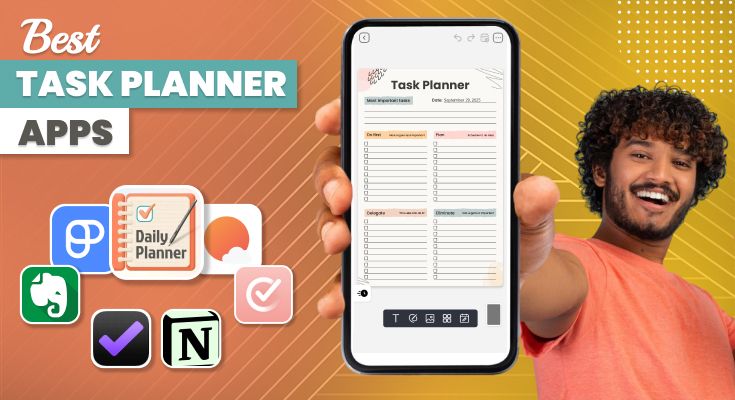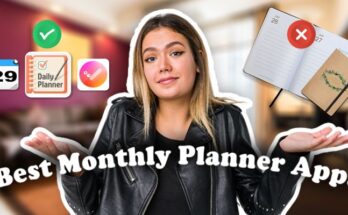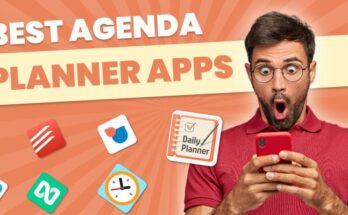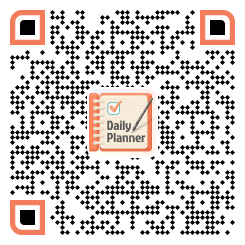Managing tasks and staying organized can sometimes feel overwhelming, especially when balancing work, personal goals, and daily responsibilities. Task planner apps provide reminders, schedules, and customizable planner templates to help you organize tasks, set priorities, and make planning simple and stress-free.
In this guide, we’ve reviewed the 12 best planner apps in 2026, designed to help you manage daily tasks, track habits, and achieve your goals with ease.
Quick Comparison of the Best Task Planner Apps in 2026
| App | Core Feature | Best For / Focus | Advantage | Free / Paid |
|---|---|---|---|---|
| PlanWiz | Customizable workflows | Personal goal tracking & planning | Visual boards + multiple layout options | Free / Paid |
| TickTick | Tasks + habits + calendar | All-in-one productivity | Built-in Pomodoro timer & habit tracker | Free / Paid |
| Any.do | Quick task capture & reminders | Fast daily planning | Smart reminders + voice input | Free / Paid |
| Microsoft To Do | Cross-device task sync | Office users | Seamless integration with Outlook | Free |
| Notion | Notes + tasks + databases | Full customization & teamwork | Build your own workspace & databases | Free / Paid |
| Structured | Timeline / hour-block planning | Visual daily scheduling | Time-block visualization for tasks | Free / Paid |
| Trello | Kanban boards | Team collaboration & project flow | Drag-and-drop boards + Power-Ups | Free / Paid |
| Sunsama | Guided daily routines | Mindful productivity | Daily reflection + realistic planning | Paid |
| OmniFocus | Advanced GTD task management | Power users on Apple devices | Tag-based perspectives & deep filtering | Paid |
| Plaky | Lightweight personal + team tasks | Small teams & personal planning | Simple boards + file sharing | Free / Paid |
| Evernote | Notes + tasks integration | Note-centric productivity | Combine notes, tasks, and reminders | Free / Paid |
| Things 3 | Elegant personal task planning | Minimalist Apple users | Natural language input + smooth design | Paid |
1. PlanWiz – Best for Customizable Planning
PlanWiz makes task planning simple, flexible, and visually appealing. You can start by exploring its task planner templates to organize daily, weekly, and monthly tasks effortlessly. Tasks are easy to edit with drag-and-drop, letting you adjust your schedule in seconds.
For those who want a structured start to each day, PlanWiz offers daily planner templates that help you schedule tasks, set priorities, and maintain focus. You can also share your plans with friends or teammates to stay coordinated.
Students and learners can benefit from study planner templates designed to track assignments, plan revision sessions, and manage deadlines efficiently. Tasks can be moved, updated, or reorganized easily using the intuitive interface.
If you like combining notes with your planning, PlanWiz provides notes planner templates that let you organize ideas, track tasks, and create a seamless workflow.
Why Choose: Templates let you set up daily/weekly/monthly workflows. You can color-code, drag-and-drop, or change the layout to grid, list, or calendar-style. Looks good, works well.
Pros: Fast setup, pleasing visuals, and flexible workflows.
Cons: Some team features or deep project tracking are lighter; integrations may not be as extensive.
What’s New: Recently added “theme switcher” for dark/light/golden modes + improved mobile offline syncing.
Ideal User: People who like flexibility and want their planner to double as a goal tracker.
Platforms & Pricing: Available on iOS, Android, and Web. Free tier with basic features; premium adds more layouts/integrations.
2. TickTick — Best for All-in-One Task + Habit + Calendar Mix
TickTick combines your to-do lists, calendar, and habit tracker in one space. It even includes a Pomodoro timer to help you stay on task. Perfect if you want one app instead of juggling many.
Why Choose: Tasks, calendar, habit tracker, all in one place. If you want both a to-do list and routine tracking, this helps reduce app-switching.
Pros: Good recurring task options; built-in habit tracking; comfortable across mobile + desktop.
Cons: Free plan limits some features; UI settings sometimes feel hidden.
What’s New: Improved calendar module; better widgets; faster switch between list & calendar views.
Ideal User: Users who want tasks, routines, and goals organized together.
Platforms & Pricing: iOS, Android, Web, Desktop. Free & premium tiers.
3. Any.do — Best for Quick Task Capture and Reminders
Any.do is designed for speed. With smart reminders, voice input, and a clean design, it helps you jot tasks instantly and get on with your day. It also nudges you with a “daily moment” to plan.
Why Choose: Has voice input, smart reminders, and a daily moment view that nudges you each morning to plan the day. Great for people who want minimal friction.
Pros: Very simple; good reminders; lightweight.
Cons: Less suited for big projects; fewer layout options.
What’s New: Smarter suggestions for recurring tasks; improved sync with some calendars.
Ideal User: Busy people who want a lightweight app for reminders and quick planning.
Platforms & Pricing: Phones, Web, Tablets. Free & paid versions.
4. Microsoft To Do — Best Free Tool for Office Users
Microsoft To Do integrates smoothly with Outlook and Office 365. It keeps your personal and work tasks synced across devices at no extra cost. A clean option for anyone already using Microsoft tools.
Why Choose: If you use Outlook / Microsoft 365, this fits in naturally. Tasks show up where you expect; good cross-device sync; doesn’t cost anything extra.
Pros: Solid reliability; intuitive, tight integration with MS tools.
Cons: Lacks Kanban/timeline views; design customization is limited.
What’s New: Recent update to mobile widgets; better reminder prompts.
Ideal User: Students and professionals who rely on Microsoft apps.
Platforms & Pricing: iOS, Android, Web, Windows. Free.
5. Notion — Best for Full Flexibility & Combining Notes + Tasks
Notion is more than a planner. It’s a customizable workspace where you can build your own mix of to-do lists, boards, timelines, and notes. It adapts to whatever system you want to create.
Why Choose: You can build your ideal planner: list + board + timeline + database views. If you want everything in one workspace (notes, docs, tasks), it shines.
Pros: Highly customizable; many view types; team collaboration.
Cons: Learning curve; mobile experience sometimes slower; free plan has some storage / upload limits.
What’s New: New “Feed” view; more relational database options; template improvements.
Ideal User: Users who want a single tool for notes, projects, and task tracking.
Platforms & Pricing: iOS, Android, Web, Desktop. Free & paid plans.
6. Structured — Best for Visual & Time-Blocking Planning
Structured gives you a timeline view of your day. Tasks are shown as blocks on a schedule, so you see exactly how your time is divided. Great for time-blocking fans.
Why Choose: Focused on the flow of your day. You can map out when tasks happen; see calendar events + to-dos in blocks. Great for visualizing free vs busy slots.
Pros: Clean, intuitive; good for routines; easy drag/drop.
Cons: Light on collaboration; some premium features are only on Apple; Android/web could lag.
What’s New: Updated onboarding process; better web layout; more color-coding options.
Ideal User: People who want to plan their day hour by hour.
Platforms & Pricing: Web, iOS, Android. Free version; premium for more features.
7. Trello — Best for Team Collaboration
Trello organizes tasks into cards and boards. You can move them across columns like “To Do,” “Doing,” and “Done.” It’s intuitive and great for both personal and team projects.
Why Choose: Boards + cards make it easy to see tasks moving through stages. If you think in columns (To Do → Doing → Done), this helps you visualize.
Pros: Extremely visual; lots of power-ups/integrations; strong for small teams.
Cons: If many boards/tasks, it can get messy; calendar/timeline views often need paid add-ons.
What’s New: Improved board templates; better automation; recent enhancements to mobile-board UI.
Ideal User: Visual thinkers and teams that like Kanban boards.
Platforms & Pricing: Web, iOS, Android. Free plan; premium versions.
8. Sunsama — Best for Guided Daily Work Routines
Sunsama encourages mindful productivity by helping you plan tasks realistically each day. It integrates with other tools and guides you to focus without overloading.
Why Choose: Forces a daily check-in: select tasks, plan your day, then reflect. Encourages realistic planning.
Pros: Helps avoid overcommitting; strong daily discipline; focus-mode features.
Cons: Price is higher; not much flexibility to deviate from its structure; limited free options (if any).
What’s New: Recent addition of morning “Highlights” summary; deeper calendar integrations.
Ideal User: Professionals seeking a balanced, reflective approach to work.
Platforms & Pricing: Web, Mobile. Premium subscription.
9. OmniFocus — Best for Deep Task-Management Power
OmniFocus is built for power users who follow the GTD (Getting Things Done) method. It allows detailed tagging, filtering, and reviewing to manage complex projects.
Why Choose: If your tasks are complex and need tagging, perspectives, and review cycles, OmniFocus can handle it. Best in GTD frameworks.
Pros: Very robust; powerful filters; reliable performance on Apple devices.
Cons: Only on Apple; steep learning curve; costlier; might be overkill for simple tasks.
What’s New: Improved synchronization; updated interface tweaks; better support for shortcuts / automations.
Ideal User: Apple users who need advanced organization and productivity systems.
Platforms & Pricing: iOS, macOS. Paid app/subscription.
10. Plaky — Best for Balancing Personal & Team Planning
Plaky makes it easy to plan tasks individually or with a team. It offers simple boards, subtasks, and file sharing without overwhelming you with too many extras.
Why Choose: You get both personal daily planning tools and team collaboration. Good flexibility + templates.
Pros: Boards, subtasks, comments, file attachments; feels modern; free version works.
Cons: Some integrations are missing; deeper project roadmapping might require other tools.
What’s New: More template options; improved board view; better mobile-app polish.
Ideal User: Small teams or individuals who need lightweight collaboration.
Platforms & Pricing: Web, iOS, Android. Free tier; paid tiers.
11. Evernote — Best for Combining Content, Notes & Tasks
Evernote started as a note-taking app but now includes tasks. You can capture research, ideas, or meeting notes, then turn them into actionable steps without leaving the app.
Why Choose: If your planning involves writing, research, idea capture, + action, you save time by keeping everything in one place.
Pros: Excellent search; multi-format notes; reminder + to-do list support.
Cons: Task tools are more basic; heavy features are behind a paywall; less built for fast everyday task shifting.
What’s New: Better collaboration on shared notebooks; improved mobile note editors; slight improvements in task reminders.
Ideal User: People who combine note-taking with planning.
Platforms & Pricing: iOS, Android, Web, Desktop. Free & paid.
12. Things 3 — Best for Elegant, Minimal Personal Planning
Things 3 is known for its beautiful design and smooth task flow. With natural language input and polished navigation, it feels effortless to use for personal task planning.
Why Choose: Beautiful interface, lovely animations, very smooth for personal tasks; natural language input possible; good repeat/checklist support.
Pros: Clean, satisfying to use; reliable; polished UI.
Cons: Not cross-platform; no free version; limited for teamwork; fewer “non-linear” views.
What’s New: Recent improvements in widget functionality; better support for Dark Mode/system themes; faster syncing.
Ideal User: Apple users who value design and simplicity over heavy features.
Platforms & Pricing: iOS, macOS. Paid purchase/subscription model.
Frequently Asked Questions
PlanWiz, Notion, and TickTick offer highly customizable templates. PlanWiz stands out with editable daily, weekly, and monthly layouts. Notion allows building your own workspace, while TickTick provides recurring tasks and habits integration.
Yes. Free task planner apps include PlanWiz, TickTick, Any.do, Microsoft To Do, Trello, Plaky, and Evernote. Paid apps like Sunsama, OmniFocus, and Things 3 provide advanced features such as collaborative tools, time-blocking, and elegant design.
Trello, Plaky, PlanWiz, and Notion work well for collaborative planning. Trello offers Kanban boards for teams, Plaky has lightweight shared tasks, PlanWiz allows template sharing, and Notion enables team databases and task boards.
TickTick, PlanWiz, and Any.do are great for habit tracking alongside task planning. TickTick has built-in habit tracking, PlanWiz integrates habits with schedules, and Any.do provides recurring reminders to build routines.
Final Thought
Organizing your tasks doesn’t have to be stressful. Using a task planner app like PlanWiz allows you to manage daily tasks, track habits, and plan goals all in one place. The right app can streamline your workflow, help you prioritize effectively, and make productivity feel natural instead of overwhelming.
How to get started:
- Check out ready-made templates or create custom layouts to match your daily, weekly, or project needs
- Set reminders and alerts to stay on track with important tasks
- Combine to-do lists with habit trackers to maintain consistency over time
- Try different views, such as lists, calendars, or boards, to see what fits your style best
Begin using PlanWiz today to organize your tasks efficiently, stay focused on priorities, and make task management simple and stress-free.
Learn More:
Free Customizable Daily Task Reminder Planner Template
How Teachers Can Manage Classroom Tasks Using a Notes Planner
Streamline Task Management for Teachers with a Smart To-Do List App








